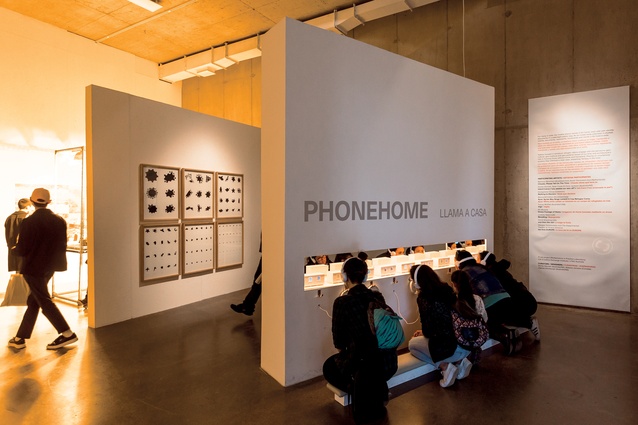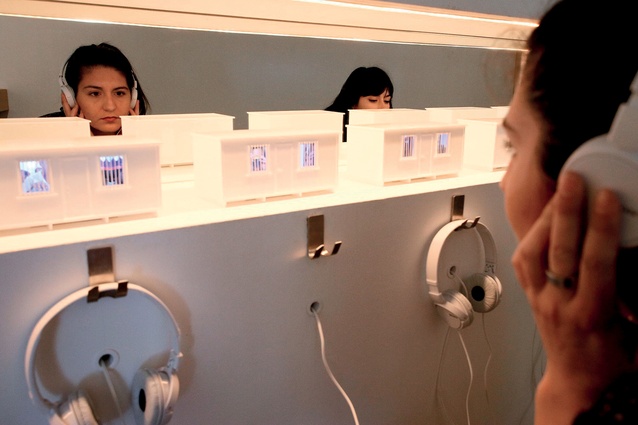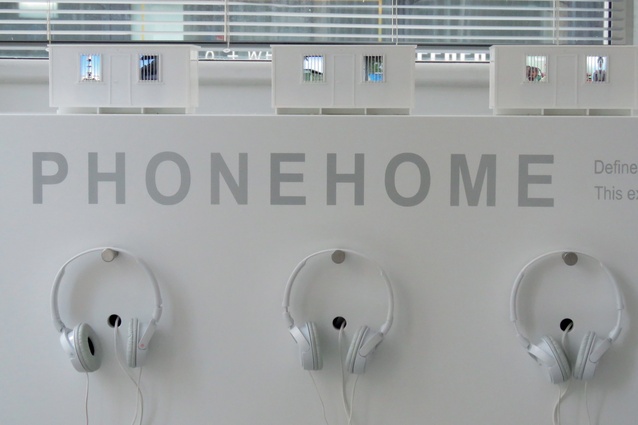Review: PhoneHome
The role of smartphones in the lives of refugees and homeless asylum-seekers is the subject of the PhoneHome exhibition. It was presented at Chile’s Architecture Biennial and during New Zealand’s Architecture Week, and is reviewed here by Tommy Honey.
The dislocated Extra-Terrestrial in the 1982 movie E.T. must ‘phone home’ to reconnect to his kind. In this exhibition, this alien instruction is co-opted to contextualise the role of the smartphone for those ‘aliens’ dispossessed of their homes and their countries, drawing attention to the search for asylum and their treatment at the hands of the ‘homed’.
For these homeless – and often stateless – the phone becomes a proxy for a home, securely kept along with identity documents in a waterproof plastic bag. Borders are meaningless to refugees and cellphone signals. Smartphones enable the global connectivity of these new nomads, locating the dislocated and allowing digital release from the detention camps and refugee centres that physically constrain them.
The exhibition was first proposed as a P-Lab project (Performance in Practice Laboratory) at the University of Tasmania’s Creative Exchange Institute (CXI), an interdisciplinary and collaborative test site for the critiquing and re-imagining of the contemporary world.
Led by New Zealand architect and performative researcher Dorita Hannah, along with Shauna Janssen of Canada and Joanne Kinniburgh, also of Australia and New Zealand, the proposal for an installation was jury-selected for exhibition at Unpostponable: the XX Chilean Architecture and Urbanism Biennial in Valparaiso and shown in November 2017. It has since been presented at the Ellen Melville Centre in Auckland for Architecture Week 2018 and was then displayed at the University of Auckland’s School of Architecture and Planning.
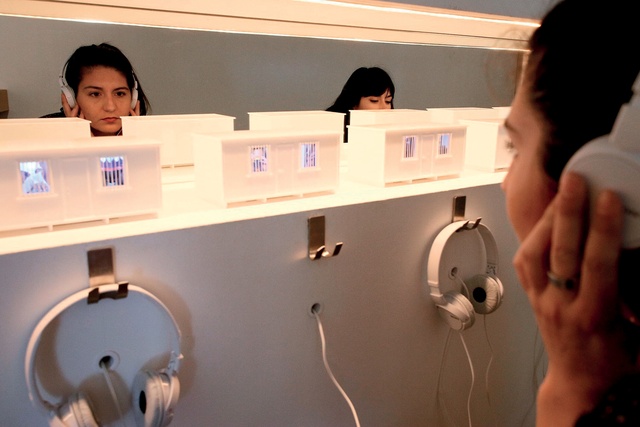
Nine participating artists and correspondents have contributed videos which are played on smartphones secreted in models of buildings based on refugee cabins. To view the videos, the viewer must literally get down on their knees and sit, crouch, squat or kneel to look inside the cabins.
There is something decidedly Swiftian about the giants of Western privilege prostrating themselves to peer in at the little people. The inner walls of the cabins adjacent to the smartphone screens are mirrored, creating infinite versions of the videos, hinting at the enormity of the issue.
Straining for a closer look can suddenly reveal your own eye looking back at you, magnified; this, perhaps, is the point. Soundtracks for the videos are played through headphones, heightening the exclusive aspect of the project while simultaneously making the experience intimate and excluding: again, the point.
The architecturalising of the idea mixes traditional forms of representation – the model – with the more contemporary digital mode of moving image, setting up an unsettling examination of an unsettled issue. Refugees and asylum-seekers – from Syria to Manus Island to Texas – are easily contained within our consciousness as ‘other’; here, we are the other, the stories and reflections of the displaced are privileged and given centre stage. Or centre phone.
In Rescue4Children’s submission, Ayaz: Syrian Boy Sings Lament in Iraq Refugee Camp, a young Kurdish boy, the personification of innocence, does exactly that; his lament is for his mother, his homeland and the pain of distance. In Vigil, Australian artist Tracey Moffatt cuts between images of refugees on boats with Hollywood film stars (Elizabeth Taylor, Cary Grant, Jimmy Stewart) peering through blinds, highlighting the gulf between their separate realities.
Moffatt’s commentary on this crisis is of “white people gawking at desperate, poor brown people in boats”. The actors and, by extension, we, are made uncomfortable voyeurs of things we would rather not see. By way of reference to Hitchcock’s Rear Window particularly, our discomfort is made compelling, compulsive and compulsory. Moffatt will not let us avert our eyes.
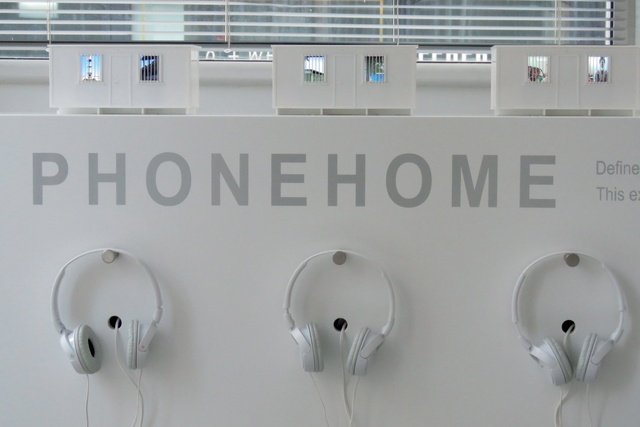
Tea time EUROPE, by the Experimental Theatre of Thrace and directed by Giorgos Zamboulakis, is a performance piece of six people, initially sitting on chairs up to their knees in the waters of the Evros River delta, which borders Greece and Turkey and is a major entry point for migrants into Europe.
The ritual of drinking tea is magnified through rhythmic sounds made with the teacups and, then, on the bodies of the participants and through chanting. A woman sings an aria as the bodies slowly collapse into the water. The original performance was eight hours long, accentuating the arduous trials of migration.
One of the more beguiling videos is Drone Footage of Homs, Syria, from the RT news channel, which highlights the role of drones both in the destruction of war and the capture of news footage. The New York Times has referred to this drone footage as “images [that] might evoke scenes from a post-apocalyptic video game”, illustrating both the immediacy of media images facilitated by the use of drones and the casual distancing of the medium of video gaming, which often exploits the war-torn for entertainment. In this video – no game – the drone traverses the abandoned city showing the empty horror of destruction.
The all-white, laser-cut cabins are both toys for our interest and mini sun-drenched prisons for our contempt. They amply encompass the paradox of detention and introspection. For, while we might engage with these simulacra for a few minutes, hours, a day, ultimately, we move on. For those who inhabit them, in their full-sized 1:1 horror, the experience is unrelenting and possibly eternal.
This article first appeared in Architecture New Zealand magazine.


